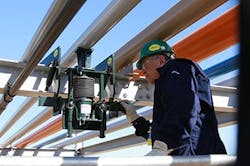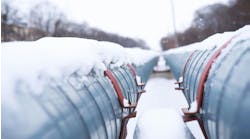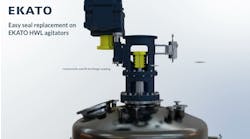Refinery Pipe Inspections Get A Lift With New Device
Inspecting for external corrosion at piping contact points in refineries is challenging. As pipe coatings and insulation systems age, the potential for water ingress increases, making external corrosion of piping inevitable. Additional factors such as steam tracing leaks that can introduce the potential for moisture accumulation under insulation systems often compound the threat. These conditions can and do combine to result in external corrosion of refinery piping, especially at crevices like those found at contact points. Making matters worse, the importance of installing external corrosion prevention devices, such as rain rods, pipe shoes, etc., wasn’t fully recognized in older piping installations.
As a result, aging refineries diligently should check for corrosion at contact points.
The need for careful inspection certainly applies to the refinery where I work. It has been operating for 100 years and now has a capacity of 314 million bbl of crude oil per day. Output consists primarily of fuels, including all grades of gasoline, diesel fuel, propane and butane. The refinery also produces benzene and asphalt. Although our site has had major projects and renovations, including many within the last ten years, it still has decades-old in-service piping that requires scrutiny to ensure safety.
We estimated contact points using refinery plot pipe rack drawings and came up with a staggering number — 400,000! Our program calls for general screening of all contact points (line-of-sight visual assessments), close (within touching distance) visual checks of all contact points deemed as “high or moderate” risk in general screenings, and finally, pipe-lifting, nondestructive evaluation (NDE) and remediation of all contact points identified with heavy external corrosion damage.
The API-570 Piping Inspection Code and the refinery owner’s internal standards establish minimum inspection requirements and define inspection compliance timing. Our internal requirements go beyond the “standard” ones specified in relevant industry inspection codes.
Each refinery within the corporation must determine how to facilitate and execute the internal corporate requirements. The refineries differ in weather conditions, age, initial construction methods and piping arrangements, making it difficult to estimate costs and the magnitude of the work scope.
Tackling The Task
In 2017, I was given the responsibility to manage the various inspection programs defined in the corporate standard. I realized that the current inspection budget wouldn’t suffice to execute the required work. While contact point inspections are just one key aspect of the corporate standard, they do represent one of the most challenging objectives. Conventional pipe-lifting methods wouldn’t allow getting the job done in the allotted time. So, I needed to look for innovations that would help in achieving refinery inspection goals.
[callToAction]
To construct a case for the necessary resources, I set out to build scope and cost estimating tools. Next, I defined a meaningful representation of the magnitude of the work scope by estimating the number of contact points from refinery plot maps. This led to development of a 5-yr comprehensive inspection and remediation program (that was subsequently approved) to address potential issues and concerns. The scope included: defining various levels of damage to aid in prioritizing future mitigation and follow-up inspections; canvasing the entire refinery to estimate the magnitude of the inspection work scope; determining how to track and manage field information; defining work and inspection efficiencies to help in optimizing progress while minimizing costs and ensuring field execution meets the highest level of safety and productivity during inspection and pipe-lifting activities.
The primary difficulty associated with inspecting contact points is accessibility. Most reside in pipe racks, where direct-line-of-sight visual inspection from available access points is impossible or at least limited. Many are insulated.
Because scaffolding and insulation work is expensive and time consuming, we rely on rope access technicians as much as possible to facilitate these pipe rack inspections. Building a self-sufficient ropes crew provided the foundation for developing a highly effective and productive inspection strategy that contained costs and ensured meeting the compliance timing deadline.
This is where the BobbyJack Pipe Lift came into the picture. We opted for this innovative portable device because it effectively addresses some of the more-challenging aspects of safely and efficiently performing pipe lifts in limited access locations.
Contact Point Inspections
One of the most challenging activities involved in performing contact point inspections safely and effectively is lifting active pipes. Our refinery has used conventional pipe-lifting methods for many years. However, these techniques pose limitations and disadvantages, which the unprecedented scale of the contact point inspection program magnified.
Lifting piping with chain falls, straps, etc., requires rigging off other piping or structure above the subject pipe. This isn’t a preferred option and demands even more evaluation and engineering. In addition, in some cases, no acceptable lifting point is available. Crane support requires the use of spotters, the cost of the crane and operator and, sometimes, working without direct eye contact between the rigger and the crane operator.
Figure 1. Portable device provides both efficiency and easy operation by one person.
After some research, we discovered the BobbyJack and decided to use it to support such activities (Figure 1). Key features that make this option attractive include:
• Safety. The BobbyJack pipe-lifting device offers distinct advantages over conventional pipe-lifting options such as cranes/slings and chain falls because it’s completely within the control of the person lifting the pipe; lifts are made gradually with the jack and you don’t have to rig off other pipes.
• Portability. The unit can go almost anywhere it’s needed with minimal clearance requirements. A small “lifting crew” can manage it with no additional manpower support.
• Efficiency. Because the person doing the lift manages the jacking system, other resources like cranes and additional craft support aren’t needed.
• Ease of operation. The system is easy to understand and operate. With only minimal training and experience, lifting crews can be qualified to make pipe lifts safely and effectively with it.
Using the BobbyJack pipe-lifting tool is a simple 10-step process:
1. Check the thickness of the top flange of the pipe support. (BobbyJacks are designed specifically to work with I beams or opposing C-channels). If the flange is less than ½-in. thick, install a box shim on the hook and secure in place with a shim-retaining pin (all parts included). If the beam is ½-in. thick or greater, don’t use the shim.
2. On the pipe to be lifted, place one of the support arms of the BobbyJack across the top flange of the beam.
3. Pull the arm toward you to fully engage the support arm until it’s fastened onto the opposite side of the beam.
4. Swing the pivoting brace until it’s directed at the lower inside corner of the beam between the web and the lower flange of the beam.
5. Adjust the length of the screw as required to ensure the support arm lies flat across the top flange of the beam.
6. Repeat this process for the second support arm, positioning the two arms at least 12½ in. apart.
7. Position the lifting cradle/riser assembly into the vertical slots on the support arms.
8. Place the hydraulic jack into the lifting cradle and lift the riser about 2 in. to allow the rounded cap at the top of the jack to slot into the round socket of the riser.
9. Insert the jack retaining pin through the hole in the base of the jack and the matching hole in the base of the lifting cradle.
10. Put the appropriate lifting “vee” on the riser assembly and lift the pipe.
You can insert a locking mechanism into the assembly. This eliminates the possibility of the jack allowing the lifted pipe to fall back onto the support; it is a great safety feature.
Maintaining the safety and mechanical integrity of the piping during pipe-lifting activities requires a robust pipe lift policy. This should ensure that critical aspects of each lift have been considered and addressed. Key elements of such a policy include: an operations contingency plan, an engineered pipe-lift plan, inspection and NDE prior to lifting, and designation of a pipe-lift coordinator.
We have found the BobbyJack Pipe Lift to be a safe and effective way to lift piping for contact point inspections. It won’t work at every location but certainly has its place among the multiple pipe-lifting methods needed to complete our refinery-wide program.
Brad Cummins is a special emphasis inspection lead at a southern Illinois refinery. Email him at [email protected].



